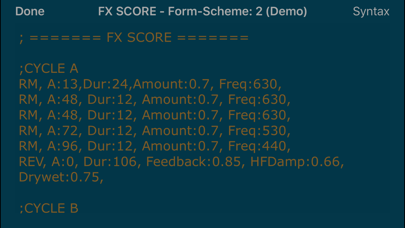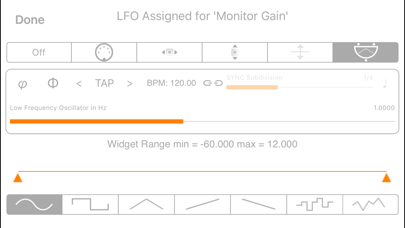SOLO [Nr.19]

Screenshots
*** This app is for the Musician who want to play SOLO [Nr.19] of Karlheinz Stockhausen for Study, Live Performance, Concerts, Lessons etc... It have not sense to employ this app otherwise.
You can hear fully the first version performed by Enrico Francioni (Contrabass) and the second version performed by Simonetta Sargenti (Violin)
***
SOLO [Nr.19] is an algorithm that aims to implement digitally the original analog set-up for the performance of six versions of Solo für melodieninstrument mit rückkopplung by Karlheinz Stockhausen.
The original composition was conceived for five persons. Four technicians plus the main instrument performer. SOLO [Nr.19], performs the work of four technicians for each of the six Stockhausen's versions.
"Solo" (für Melodieninstrument mit Rückkopplung) by Karlheinz Stockhausen is a piece written for any solo melodic instrument and employs a feedback system to allow the soloist to create polyphonic music. Written in 1966 with its world premiere in Tokyo in the same year, its origin dates back to the same period as the composer's work "Kontakte". "Solo" uses the technique of recording onto tape with a single head together with a moveable arrangment of playback heads, allowing for the creation of complex sounds through accumulation.
The original version (with an analog technical set-up) requires a solo instrumentalist as 4 assistants (technicians): three assistants operating the opening and closing of sliders (L/R channels)–respectively the microphone, delay-line and output–and an assistant for the change of time values of the taps in the delay-line. During a performance a part of what the instrumentalist plays is captured by a two-channel recorder. Through a feedback circuit, the sections are recorded more or less densely stacked and processed with a variable delay time; the result is then played by two sets of speakers and mixed with the direct sound of the soloist.
The score (Universal Edition-Wien, 1969) consists of six pages of music and six pages of Form- Schema (the number six can be considered a key element), in addition to explanatory notes (very detailed) for the performance the composition. "Solo" is one of those compositions by the author employing "controlled alea" as a compositional language. Indeed many choices are left to the soloist and cover almost all the events: from the selection of a version, the positioning of the material, the types of tonal variation requests, the order of pages and more. In reality these faculty are provided as input by the composer through the management of macroscopic or microscopic order parameters, restricting the possible versions (virtually infinite) at a predefined or definable set of possibilities. In this piece, the role of the interpreter is very important in the creation of a performance that is always unique and unrepeatable every time.
App Privacy
The developer, Alessandro Petrolati, has not provided details about its privacy practices and handling of data to Apple. For more information, see the developer’s privacy policy
No Details Provided
The developer will be required to provide privacy details when they submit their next app update.
Ratings and Reviews
Ratings and reviews are verified
-
CAinOH, 06.09.20191 star now; 5 stars a couple years agoUsed to be a neat app, but at some point the default sample rate on my iPad and iPhone was switched from 44.1 to 48 (I have to assume as Show more
-
erleichda, 24.07.2014IAP for Audiobus?Doesn't that violate the Audiobus license? "No In-App Purchase For Audiobus Support In Apps"
Information
-
Category
-
Age Rating4+
-
PriceFree
-
Size62.13 MB
-
ProviderapeSoft
Languages
English
Copyright
©
2004-2025 Alessandro Petrolati. All rights reserved.


